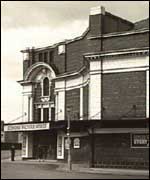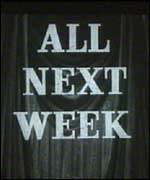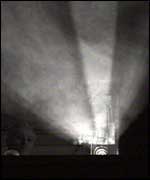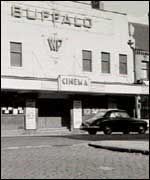|
At the peak of cinema going in 1938, the North East boasted over 300 cinemas, many of them small and intimate.
Many early cinemas were built in working class areas such as Ashington in Northumberland which had over 4,000 seats in five cinemas in the 1940s.
Today there are just 400 cinemas in the whole of the UK despite the boom in multiplex cinemas.
Moving Pictures
 |
|
Jesmond Cinema was one of many suburban cinemas |
Cinema was the single most popular form of entertainment in the 1920s, 30s and 40s. It was an escape for the Depression and the troubles of the war.
Before the television age, a trip to the pictures was a great way of having fun - and it was cheap. Saturday morning shows and matinees became an institution for a generation of children.
As the large cinema chains moved into the region, larger movie houses became more opulent.
The Paramount Cinema which opened on Pilgrim Street in Newcastle in 1931, became the region's first glamorous American-style movie palace.
Films varied from big Hollywood features to B-movies, shorts and news reels. Westerns, musicals and romantic dramas were particularly popular with box office hits like 'Gone With the Wind' and 'Sergeant York'.
The Home Front
During the Second World War a night at the pictures became a popular escape from the dark, dreary days of the war. National cinema audiences boomed, trebling to over 30 million every week.
In Sunderland alone, there were 18 new cinemas granted licences in 1940 including the Villiers Electric Theatre and the Cora Picture Palace. Three cinemas were destroyed in the bombing raids including the King's Theatre in 1943.
Some cinemas were really basic and were nicknamed 'flea pits' or 'the loppy opera' after the fleas that bit audiences sitting in the less than salubrious auditoriums.
Reel Lives
 |
|
Going to the cinema was hugely popular in working class communities |
The Tyneside Cinema in Newcastle opened as the 'Bijou News-Reel Cinema' on 1st February 1937. It was one of three news theatres that opened in the city that year.
The first programme in the News Theatre was a 75 minute mixture of news, travel, sport and cartoons.
The inaugural performances consisted of 'Nature in Colour – Siamese Fighting Fish', a look at the Town and Gown traditions of Oxford and Cambridge, and a study of the Italian Airforce taking part in training missions.
The aspect of the programme that everyone thought would be the biggest hit was the revolutionary sound design. 'Audioscopics' was a "new stereoscopic film entertainment in which people throw balls, push ladders and squirt soda right up to within an inch of your nose – or at any rate you think they do."
Programmes were continuous from 10.30am, and cost 6d. and 1s. The auditorium, now Cinema One, seated 412 in comparison to today's seating total of 268.
The Tyneside Coffee Rooms opened in 1938, a year after the News Theatre opened. As well as this and the main screen, the building's facilities also included a private cinema, a tea club and a men-only smoking room.
 |
|
Lights, camera, action... |
Besides running newsreel footage, the Cinema was also home to a number of film societies including the Tyneside Film Society, the King's College Film Society and the Indian Association Film Society.
In early 1968, the News Theatre finally succumbed to competition from television and closed down. It was soon to reopen as the Tyneside Film Theatre. The first screening on the opening day on 17th March 1968 was the then notorious 'Hugs and Kisses', a parody of Swedish sex comedies from director Jonas Cornell.
The films screened at the Tyneside Film Theatre were similar to those shown by the Tyneside Film Society - world and independent cinema.
The Film Theatre closed down in 1975 – and a 4,000-strong petition urging the powers-that-be to relent and help reopen the Tyneside.
Later in 1976, the Cinema reopened as the Tyneside Cinema. Since then, the building has undergone refurbishment and has installed a new neon sign, designed as a hark back to the initial frontage of the News Theatre when it first opened in 1937.
Living It Up
 |
|
The Buffalo was a popular small cinema |
By the 1960s Northerners were still flooding to the pictures although television was starting to pose a threat.
Newcastle alone boasted 17 cinemas in the '60s but by the late 1970s, only a few remained - the Odeon, the ABC (Haymarket and Westgate Road) and the Tyneside Cinema.
Sunderland was also down to just one cinema - the ABC on Holmeside. Some towns had lost their cinemas completely with smaller chains like the Wallaw group suffering the worst of the blows.
Many smaller cinemas such as the Regal in Ashington and the Gosforth cinema in Newcastle were razed to the ground.
It was the end of an era, and after a period in the doldrums, reinvented itself in the form of the modern multiplex cinema.
|

